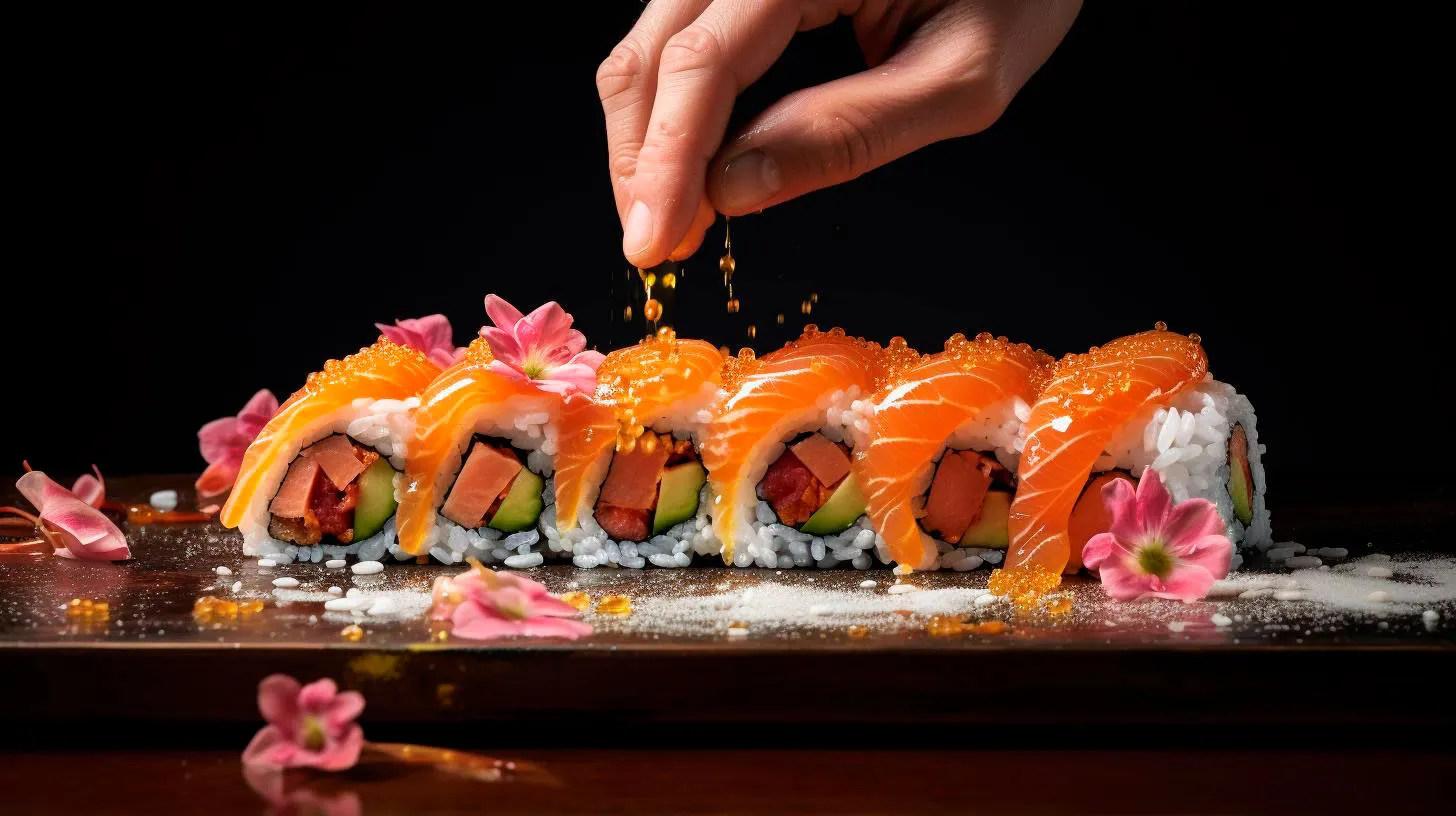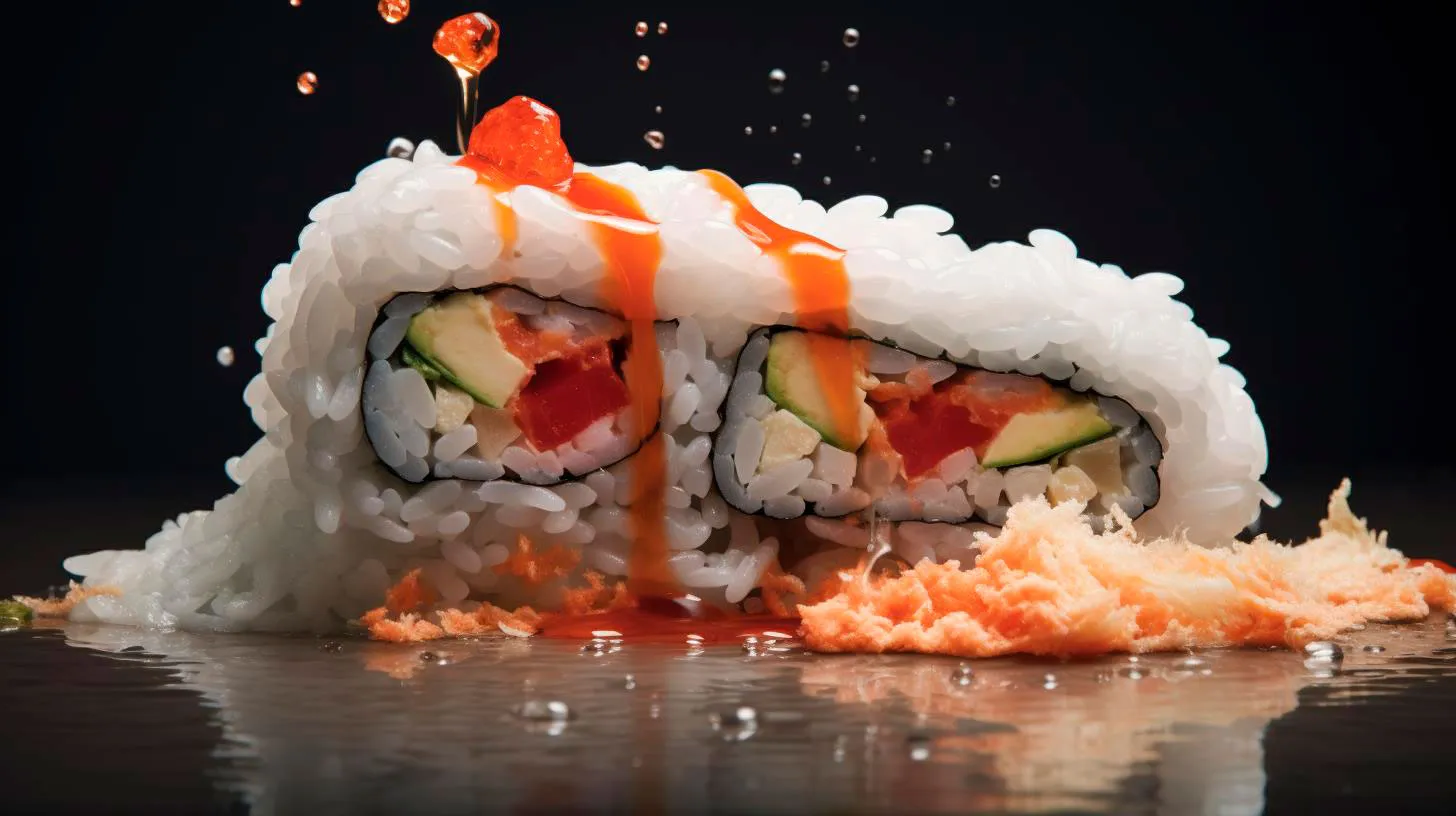Savoring Authentic Flavors: The Japanese Culinary Heritage
From delicate sushi rolls to hearty bowls of udon, exploring the intricacies of Japanese culinary heritage is a delight for food enthusiasts around the world.
A Journey Through Time
Japanese culinary traditions date back thousands of years, with influences from neighboring countries such as China and Korea. Over time, these culinary practices have evolved, resulting in a unique and distinct gastronomic identity. Here are a few key points to highlight about Japanese culinary heritage:
- Fresh and Seasonal Ingredients: Japanese cuisine emphasizes the use of fresh, high-quality ingredients. From succulent seafood and tender meats to crisp vegetables, the focus is on letting the natural flavors shine.
- Precision and Attention to Detail: Japanese chefs are known for their meticulous attention to detail. Whether it’s the perfect sushi roll or the artful presentation of a traditional kaiseki meal, every dish is prepared with utmost precision.
- Umami Richness: Umami, often referred to as the “fifth taste,” is a key element in Japanese cuisine. From the savory miso soup to the complex flavors of soy sauce, umami adds depth and richness to dishes.
- Seasonal Adaptability: Traditional Japanese cuisine embraces the changing seasons and incorporates seasonal ingredients in its recipes. This ensures that the flavors are at their peak, providing a truly unique experience.
The Beauty of Washoku
At the heart of Japanese culinary heritage lies “Washoku.” In 2013, Washoku was recognized as an Intangible Cultural Heritage by UNESCO. It represents the traditional dietary culture of the Japanese people and embodies harmony, balance, and respect for nature. Here are some key takeaways from Washoku:
- Balance: Washoku aims for a balance of flavors, colors, and textures in every meal. The famous bento boxes beautifully showcase this balance, with an array of dishes that cater to all senses.
- Seasonal Appreciation: Washoku celebrates the seasonal changes by incorporating ingredients that highlight nature’s bounty. For example, sakura (cherry blossoms) are utilized in spring, while persimmons are enjoyed during autumn.
- Artistic Presentation: The Japanese concept of “Ichi-go Ichi-e” (one moment, one meeting) is reflected in the artful presentation of Washoku dishes. Every plate is crafted with care to create a feast for the eyes.
- Healthy and Nutritious: Washoku is renowned for its health benefits, focusing on fresh and minimally processed ingredients. It includes a variety of ingredients like seafood, vegetables, and fermented foods, ensuring a well-rounded and nutritious diet.
Popular Japanese Dishes
No exploration of Japanese culinary heritage would be complete without indulging in some of its iconic dishes. Here are a few renowned delicacies that have captivated food lovers worldwide:
Sushi
Sushi is arguably the most internationally recognized Japanese dish. Made with vinegared rice and topped with a variety of ingredients, such as fresh fish or vegetables, sushi offers a harmonious blend of flavors. Whether you prefer the simplicity of nigiri or the vibrant rolls of maki, sushi is a must-try culinary delight.
Ramen
Ramen, a comforting bowl of noodles in savory broth, has gained tremendous popularity globally. With regional variations and a plethora of toppings to choose from, this soul-warming dish offers a diverse range of flavors. From the rich and creamy tonkotsu ramen to the refreshing shoyu ramen, each bowl is a sensation.
Tempura
Tempura is a deep-fried dish that showcases the lightness and crispiness of Japanese cuisine. Ingredients like prawns, vegetables, and seafood are coated in a delicate batter and fried to perfection. The result? Golden, crunchy goodness that highlights the natural flavors of the ingredients.
Sukiyaki
Sukiyaki is a popular hot pot dish that features thinly sliced beef cooked with vegetables, tofu, and noodles in a sweet and savory soy-based broth. This communal dish is not only a feast for the taste buds but also a wonderful opportunity to bond with friends and family around the table.
Preserving Japanese Culinary Heritage
As the world becomes increasingly interconnected, it’s essential to preserve and promote the rich culinary heritage of Japan. Here are a few ways in which this heritage can be celebrated:
- Support Local Restaurants: Visit your local Japanese restaurants and try authentic dishes prepared by skilled chefs.
- Cooking Workshops: Participate in Japanese cooking workshops to learn traditional techniques and recipes.
- Food Tourism: Embark on a culinary journey to Japan, exploring regional specialties and engaging in local food experiences.
- Cultural Exchange: Engage in cultural exchange programs that promote understanding and appreciation of Japanese culinary traditions.
Savoring the flavors of Japanese culinary heritage is not just about enjoying a meal; it’s an immersion into a rich tapestry of history, culture, and craftsmanship. With each bite, you embark on a sensory adventure that captivates the taste buds and leaves a lasting impression. So, next time you have the opportunity to relish an authentic Japanese dish, take a moment to appreciate the centuries-old traditions behind it and savor the flavors that have stood the test of time.
Exploring Food Documentaries: A Gastronomic Journey
From uncovering diverse culinary cultures to shedding light on important food-related issues, food documentaries provide us with a captivating and educational experience.
The Rise of Food Documentaries
In an era where streaming services dominate our entertainment choices, food documentaries have quickly gained a loyal following. These documentaries have turned into a cultural phenomenon, with highly acclaimed chefs, food enthusiasts, and even renowned directors jumping on board to showcase their passion for gastronomy.
Let’s explore some key reasons behind the rise of food documentaries:
- Celebrity Chefs: Many celebrity chefs, such as Anthony Bourdain, have successfully transitioned from the kitchen to the camera, offering viewers an authentic look into different food cultures and traditions.
- Social Awareness: Food documentaries often highlight important issues surrounding the food industry, including sustainability, food waste, and the impact of our dietary choices, prompting viewers to think differently about their consumption habits.
- Food as Art: With stunning visuals, food documentaries transform the act of cooking into an art form, making it visually appealing and emotionally captivating.
- Culinary Exploration: Food documentaries take us on culinary adventures around the world, immersing us in different cultures and cuisines, broadening our understanding and appreciation for global gastronomy.
The Impact of Food Documentaries
Food documentaries have, without a doubt, made a significant impact on our society. Here are some key takeaways from their influence:
Increased Awareness
Mindful eating, sustainable sourcing, and understanding the journey of food from farm to plate are just a few examples of the themes highlighted by food documentaries. By showcasing these issues, these films have played a crucial role in raising awareness among viewers and inspiring them to make more informed food choices.
Cultural Exchange
Food documentaries provide a gateway into diverse cultures around the world. As viewers embark on gastronomic journeys to different regions, they gain a deeper understanding of cultural practices, traditions, and the role that food plays in shaping societies.
Educational Value
Food documentaries not only entertain us but also educate us about the intricacies of the culinary world. From exploring unique ingredients to diving into the science of cooking, these films provide valuable insights and knowledge for budding chefs and food enthusiasts alike.
Must-Watch Food Documentaries
If you’re looking to embark on a gastronomic journey through the lens of food documentaries, here are some must-watch films:
1. “Jiro Dreams of Sushi” (2011)
This critically acclaimed documentary follows the story of Jiro Ono, an 85-year-old sushi master, and his pursuit of perfection. Explore the dedication and craftsmanship behind sushi making in this visually stunning film.
2. “Chef’s Table” (2015 – Present)
A Netflix original series, “Chef’s Table” takes viewers into the kitchens of some of the world’s most renowned chefs. From exploring their unique culinary philosophies to witnessing their artistic creations, this series offers an intimate look into the minds of culinary geniuses.
3. “Food, Inc.” (2008)
Delve into the complex world of the food industry in “Food, Inc.” This eye-opening documentary exposes the realities of industrialized farming, the impact on our health, and the global consequences of our food choices.
4. “Salt Fat Acid Heat” (2018)
This delightful series, hosted by Samin Nosrat, explores the fundamental elements of good cooking – salt, fat, acid, and heat. As she travels the world, Nosrat reveals how these elements can transform any dish into an extraordinary culinary experience.
The Future of Food Documentaries
The popularity of food documentaries shows no signs of slowing down. As we move forward, these documentaries hold even more potential to impact the way we think about food. Here are some exciting trends to watch out for in the future:
- Virtual Reality Experiences: Imagine stepping into the shoes of a chef, exploring their kitchen, and experiencing their creations through virtual reality. This immersive technology could take food documentaries to a whole new level.
- Interactive Storytelling: With interactive documentaries, viewers may have the opportunity to participate actively in the storytelling process, making decisions that shape the narrative and their experience.
- Focus on Health and Well-being: As society becomes more health-conscious, food documentaries may increasingly focus on educating viewers about the connection between diet, nutrition, and overall well-being.
In conclusion, food documentaries offer a captivating blend of culinary exploration, storytelling, and educational value. Whether you are a food lover or simply seeking inspiration, these films provide a fascinating window into the world of food and its impact on our lives. So, grab some popcorn, cozy up on your couch, and let these documentaries take you on an extraordinary gastronomic journey.
Gourmet Sushi: A Fusion of Flavors and Techniques
Exploring the World of Gourmet Sushi
Gourmet sushi is not just about raw fish and rice; it’s a gastronomic adventure that tantalizes your taste buds and pushes the boundaries of traditional sushi. Chefs adeptly blend traditional Japanese ingredients with influences from other cuisines, resulting in a fusion of flavors and techniques that are both exciting and innovative.
Key Takeaway: Gourmet sushi offers a unique dining experience that combines traditional Japanese ingredients with a fusion of flavors from around the world.
The Advantages of Gourmet Sushi
When compared to traditional sushi, gourmet sushi presents a myriad of advantages that elevate it to a whole new level of culinary excellence:
- Flavor Combinations: Gourmet sushi ventures beyond the traditional raw fish and rice combination by incorporating different and unexpected ingredients. From fruits and vegetables to various types of seafood, each bite explodes with distinctive flavors.
- Artistic Presentation: Gourmet sushi is a feast for the eyes as well as the taste buds. Chefs meticulously arrange colorful ingredients into visually stunning masterpieces that are almost too beautiful to eat.
- Creative Techniques: Gourmet sushi chefs are known for their creativity and willingness to experiment. They often incorporate unconventional techniques like molecular gastronomy or tempura frying to add unique textures and flavors to their creations.
- Health Benefits: While sushi is generally considered a healthy food option due to its fresh ingredients and minimal use of oil, gourmet sushi takes it a step further. Chefs often incorporate superfoods like avocado and seaweed, which are rich in essential nutrients and beneficial for overall health.
Key Takeaway: Gourmet sushi offers advantages such as diverse flavor combinations, artistic presentation, creative techniques, and additional health benefits.
The Fascinating World of Sushi Fusion
Sushi fusion is a popular trend that combines traditional Japanese sushi with flavors and techniques from other cuisines. This creative approach breathes new life into sushi, allowing chefs to experiment with ingredients and methods that result in unforgettable taste experiences.
Sushi fusion can take various forms, including:
- Tempura Sushi: This innovative twist combines the delicate flavors of sushi with the crispy texture of tempura batter. The resulting combination is a delightful contrast of crunch and freshness.
- Nikkei Sushi: Nikkei cuisine, originated from Japanese immigrants in Peru, fuses Japanese and Peruvian flavors. This unique blend often incorporates ingredients like cilantro, jalapenos, or vibrant Peruvian spices to create bold and exciting sushi creations.
- Korean Sushi: Known as “Kimbap,” Korean sushi features ingredients like pickled radish, spinach, and perilla leaves. It offers a distinct Korean flavor profile, adding a spicy and tangy twist to traditional sushi.
Key Takeaway: Sushi fusion incorporates various culinary traditions, such as tempura sushi, Nikkei sushi, and Korean sushi, resulting in vibrant and diverse flavor profiles.
Industry Statistics: The Growth of Gourmet Sushi
The rising popularity of gourmet sushi comes as no surprise to those who have experienced its culinary delights. Let’s take a look at some industry statistics that highlight this growing trend:
- The global sushi market is projected to reach a value of $23 billion by 2025, with a compound annual growth rate (CAGR) of 4.1% from 2020 to 2025.
- In the United States alone, sushi consumption has increased by over 25% in the past decade.
- The demand for gourmet sushi experiences has also led to an increase in sushi restaurants worldwide, providing customers with a wider range of options to explore.
Key Takeaway: The gourmet sushi industry is experiencing substantial growth, both in terms of market value and consumer demand.
In Conclusion
Gourmet sushi is a culinary fusion that combines the best of traditional Japanese flavors and techniques with the influence of global cuisines. It offers a unique dining experience, with bold flavor combinations, artistic presentations, and innovative techniques. From tempura sushi to Nikkei sushi, the world of sushi fusion is expanding, captivating food enthusiasts around the world.
As the gourmet sushi industry continues to grow, it presents exciting opportunities for chefs to push the boundaries of traditional sushi. So, whether you’re a sushi aficionado or a curious food lover, indulge in the fusion of flavors and techniques that gourmet sushi has to offer.
Sushi-Making Secrets: Learn from Top Chefs and Masters
So, put on your aprons and get ready to uncover the secrets of sushi!
The Art of Sushi
Sushi originated in Japan and has a rich history dating back over a thousand years. It has evolved from being a simple street food to a culinary art form that requires precision, skill, and creativity. The ability to make perfect sushi requires not only technique but also an understanding of ingredients, flavors, and presentation.
Here are some key takeaways when it comes to the art of sushi-making:
- Precision: Sushi is all about precision. From cutting the fish to shaping the rice, every step requires meticulousness to achieve that exquisite bite.
- Quality ingredients: The quality of the ingredients is paramount in sushi-making. Fresh, high-quality fish and perfectly seasoned sticky rice are the foundation of a great sushi roll.
- Presentation: Sushi is not just about taste; it’s also about visual appeal. The beautiful presentation of sushi adds to the overall dining experience.
Wisdom from Top Chefs and Masters
Learning from the best in the industry can elevate your sushi-making skills to a whole new level. Top chefs and masters have spent years perfecting their craft and are generous enough to share their secrets. Let’s explore some of their wisdom:
1. Practice Makes Perfect
Mastering the art of sushi-making takes time and practice. It’s like learning any other skill – the more you do it, the better you get. So, roll up your sleeves, grab a bamboo mat, and start practicing those sushi rolls. With every attempt, you’ll find yourself improving.
2. Attention to Detail
Top chefs emphasize the importance of paying close attention to every detail. From the temperature of the rice to the sharpness of the knife, every little aspect contributes to the final outcome. Take your time, be patient, and focus on creating each piece of sushi with precision.
3. Knife Skills
A sharp knife is a sushi chef’s best friend. Mastering knife skills is essential in order to make clean cuts that preserve the integrity of the ingredients. Practice your knife techniques and learn the proper way to handle a sushi knife for optimal results.
4. Balance of Flavors
Sushi is all about achieving the perfect balance of flavors. Top chefs recommend experimenting with different combinations of ingredients to create unique and harmonious flavor profiles. Understanding how each element interacts with the others will allow you to create sushi that delights the taste buds.
The Benefits of Making Sushi at Home
Now that you’ve gained some insights into the secrets of sushi-making, let’s explore the advantages of making sushi at home:
- Cost-effective: Making sushi at home can save you money compared to dining out at a sushi restaurant.
- Customization: When making sushi at home, you have the freedom to choose your favorite ingredients and experiment with different flavors.
- Fun and social: Sushi-making can be a fun and interactive activity to enjoy with family and friends. It allows you to bond over a shared culinary experience.
- Dietary preferences: Homemade sushi is perfect for catering to specific dietary needs or preferences. Whether you’re vegetarian, vegan, or have food allergies, you can customize your sushi rolls accordingly.
Conclusion
Sushi-making is an art that requires practice, precision, and an understanding of flavors. Learning from top chefs and masters can provide invaluable insights into this intricate craft. Remember to pay attention to detail, practice knife skills, and strive for a balance of flavors. By mastering the art of sushi-making, you can create your own culinary masterpieces at home while enjoying the numerous benefits it offers.



